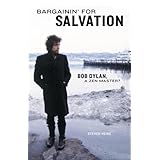
Average Reviews:

(More customer reviews)I actually heard Steven Heine speak about this book, which is why I decided to buy it. He made some very interesting points and I thought it would be a new approach to Dylan's work.
However, I am at once satisfied with the concept and disappointed with the execution. First of all, the book is filled with mistakes. I really do not believe the book was edited for either grammar and spelling or verity of information. For example, in the last paragraph of page 124, the author quotes a line from "Gates of Eden," and attributes it to "It's Alright Ma (I'm Only Bleeding)."
Second, Heine has a way of stringing together bits of lyric or song titles in an attempt to make a point which only comes off as confusing and nonsensical.
That being said, the concept of the book is very interesting and he does make insightful analyses of many songs, although in regard to some works, it seems he is way off the mark. I don't like to criticize anyone's conception of what any work of art means to them because the meaning of any decent work is in the perception of the observer. But in some cases, it seems he hasn't even read the entire work.
The most interesting part of the book is the breakdown of "Dylan Discology in Relation to Career Periods," which makes sense and provides a believable explanation for many questions about the wide-ranging positions reflected in Dylan's work. The identification of the last several years as Dylan having found the Middle Path is an intriguing concept of his latest work. But, if we know anything, it's that Dylan's music will eventually take another direction. So, where to from the Middle Path?
All in all, it is a good way to pass time, but I don't think I'll be picking it up a second time.
Click Here to see more reviews about: Bargainin' for Salvation: Bob Dylan, a Zen Master
This book argues that Dylan actually embraces two radically distinct world views at alternating periods. Throughout his various stages, Dylan's work reveals an affinity with the Zen world view, where enlightenment can be attained through meditation, self-contemplation and intuition rather than through faith and devotion. Forgoing Christianity and Western Views for Zen and Buddhism, "Bargainin' for Salvation" will capture your attention and direct it toward the East. One of the mysteries of Bob Dylan's incredible corpus is why he seems to veer and zigzag so drastically and dramatically from one extreme standpoint to another. Throughout his career, rapid, radical transitions in musical style and public persona have either inspired or shocked different sectors of his fans. Is Dylan's work complex and contradictory, or is there an underlying consistency and continuity? Steven Heine, Director of the Institute for Asian Studies at Florida International University, argues that Dylan actually embraces two radically distinct world views at alternating periods.One is prevalent in his Protest (early '60s), Country (late '60s), and Gospel (late '70s) phases; it finds Dylan expressing moral outrage in endorsing a single higher truth based on a right-versus-wrong philosophy. The second view appears during periods of Dylan's disillusionment in the mid '60s ("Desolation Row"), mid '70s ("Tangled Up in Blue"), and mid '80s ("Jokerman"), finding him disenchanted with one-sided proclamations of truth and wandering, seemingly aimless amid a relativistic world of masks and disguises where nothing is ever what it claims to be. Throughout his various stages, Dylan's work reveals an affinity with the Zen world view, where enlightenment can be attained through meditation, self-contemplation and intuition rather than through faith and devotion. Whatever his current beliefs are, though, one can go into reading this book knowing that there are no others like it. Forgoing Christianity and Western views for Zen and Buddhism, "Bargainin' for Salvation" will capture your attention and direct it toward the East.
Click here for more information about Bargainin' for Salvation: Bob Dylan, a Zen Master

0 comments:
Post a Comment